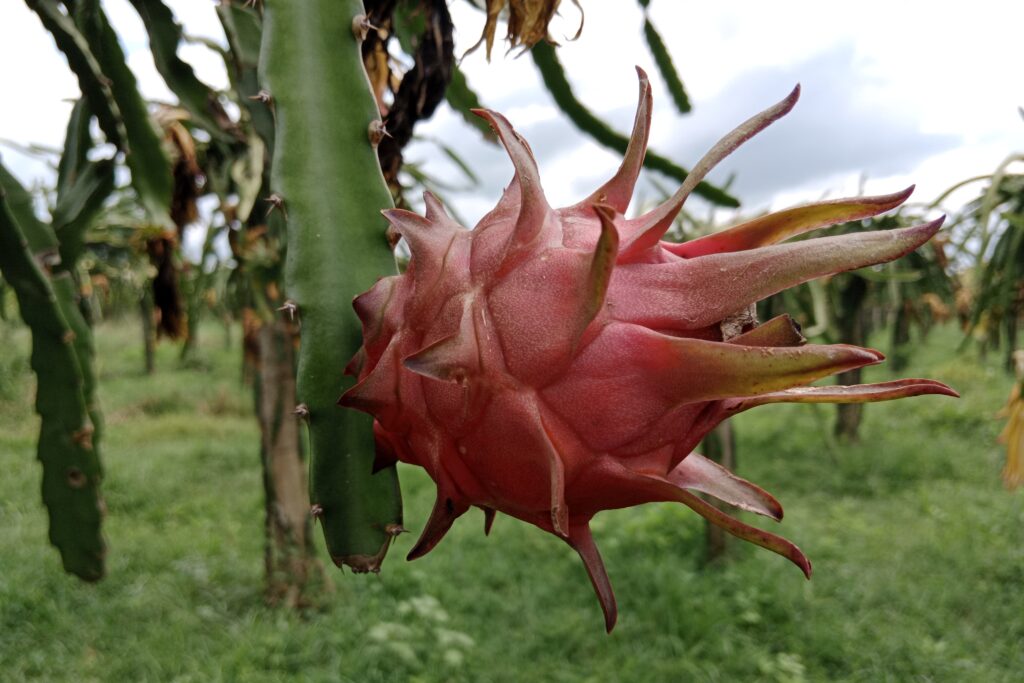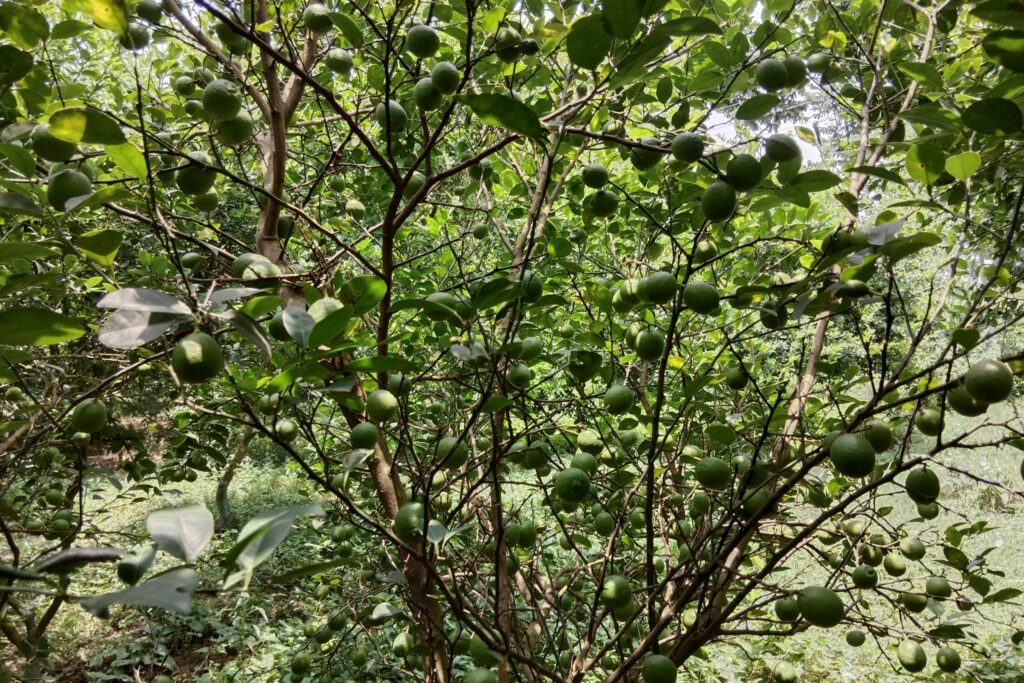Tea Farming
Tea farming is a highly profitable venture with strategic long-term planning, offering substantial returns on investment, particularly in terms of tea farming profit per acre. The financial journey begins with the initial phase (Years 1–3), where heavy losses are incurred due to significant initial investments and low yields. During this period, cumulative costs outweigh earnings as the plantation establishes itself.
However, the scenario improves remarkably in Years 4–10, as steady annual profits of approximately NRs. 50,000 per acre mark the transition toward financial stability. By the end of Year 10, the total investment of NRs. 300,000 is fully recovered, and the break-even point is reached in Year 11, where cumulative profits turn positive.
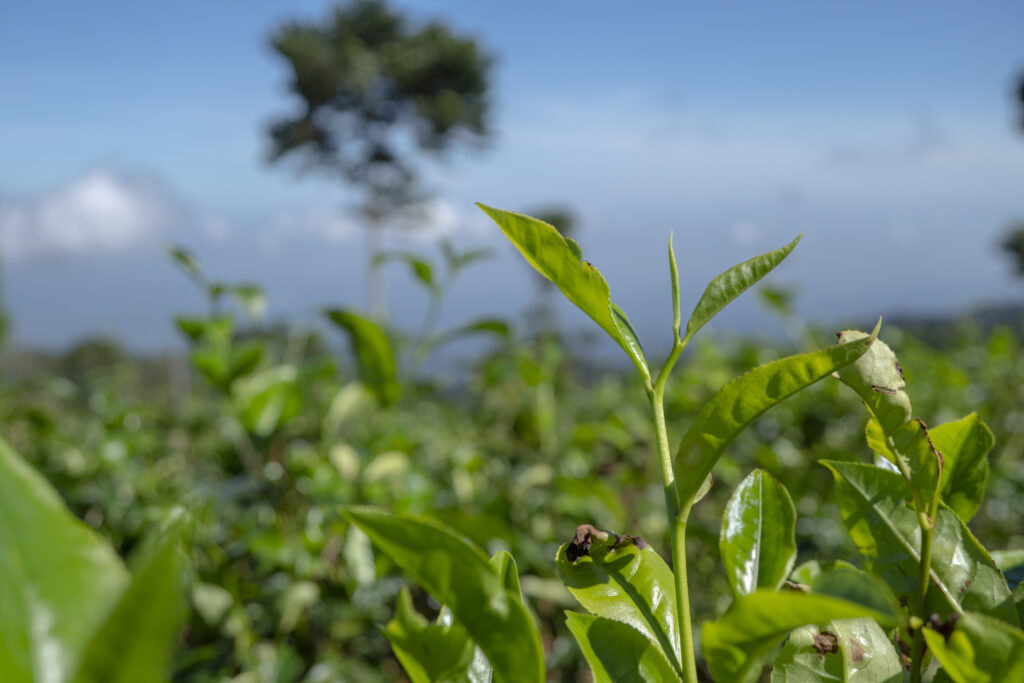
The peak profitability phase occurs during Years 11–20, with annual earnings soaring to NRs. 162,500 per acre, reflecting the optimal productive capacity of tea plants. Beyond Year 20, while yields gradually decline, the returns remain positive, ensuring sustained profitability over the plantation’s productive lifespan.
Over 40 years, the total income generated per acre amounts to an impressive NRs. 8,925,000. After deducting the initial investment and 39 years of maintenance costs (NRs. 2,250,000 in total), the net profit stands at NRs. 6,675,000. This translates to an average annual profit of NRs. 166,875 per acre, demonstrating a remarkable return on investment (ROI) of approximately 2,225%. These figures highlight the significant potential of tea farming as a lucrative and sustainable agricultural enterprise.
Land Preparation
Land preparation for tea farming is a thorough process aimed at optimizing conditions for healthy growth and sustainable production. It begins with clearing vegetation, stumps, and stones to create an open field, followed by deep ploughing to a depth of 30-45 cm to break up compacted subsoil, improve drainage, and enhance root penetration, sometimes using subsoilers for heavily compacted areas.
Harrowing and leveling refine the soil structure by breaking down clods, incorporating organic matter to boost fertility, and creating a uniform surface essential for planting and water management. On slopes exceeding 10%, contour terracing, such as bench terraces, is implemented to prevent soil erosion and improve field accessibility.
Proper drainage is a critical component, particularly in regions with heavy rainfall or poorly draining soils; strategically placed drainage channels prevent waterlogging, which can damage roots. This meticulous preparation ensures optimal conditions for planting, fostering robust plant development and long-term productivity.
Soil Type
Deep, well-drained, very acidic soil (pH 4.5 to 5.5) that is also rich in organic matter (5–10%+) is perfect for growing tea. The ideal loams are light to medium ones because clay loams store moisture and nutrients better but require adequate drainage to prevent compaction and waterlogging, while sandy loams offer good drainage but need frequent fertilization and irrigation.
Deep root development requires a minimum soil depth of 1.5 meters since shallow soils restrict growth and lessen drought tolerance. For tea to be grown successfully, a high organic matter concentration is essential since it improves the soil’s structure, moisture retention, nutrient availability, and microbial activity.
Climatic Requirements
| Climatic Factor | Requirements & Specifications |
| Temperature | • Optimal Range: 13°C to 28–32°C (55°F to 82–90°F) • Growth ceases below 13°C (55°F) and above 32°C (90°F) • Highly susceptible to frost damage • Requires winter dormancy for some cultivars. |
| Rainfall | • Annual Requirement: 1,200–2,500 mm (47–98 inches); minimum 1,000–1,200 mm (39–47 inches) • Must be well-distributed; droughts reduce yield/quality • High humidity (70–90%) is beneficial. |
| Altitude | • Grows from sea level to 2,500+ meters • Higher altitude: Slower growth, enhanced flavor compounds, higher quality, lower yield • Lower altitude: Faster growth, higher yield, potentially lower quality. |
| Sunlight | • Requires ≥4–5 hours of direct sunlight daily for photosynthesis • Intense direct sun can scorch leaves • Light shade (e.g., shade trees) benefits: ∙ Hot regions ∙ Specific teas (e.g., Matcha, Gyokuro). |
Major Cultivars
| Category | Type | Key Characteristics | Examples & Usage |
| Botanical Varieties | Camellia sinensis var. sinensis (China Bush) | • Smaller leaves • More cold-hardy • Slower growth rate • Suited to higher altitudes & cooler climates | • Basis for Chinese, Japanese, Darjeeling teas • Primarily used for Green & Oolong teas • Example: ‘Yabukita’ (Japan) |
| Camellia sinensis var. assamica (Assam Bush) | • Larger leaves • Faster growth rate • Higher yielding • Less cold-hardy • Thrives in warm, humid lowlands | • Basis for Assam, Ceylon (Sri Lanka), Kenyan teas • Primarily used for Black teas • Examples: ‘TRI 2025’, ‘TRI 2041’ | |
| Propagation Methods | Clonal Propagation | • Modern standard: Vegetative cuttings • Ensures uniformity in: – Yield & quality – Pest/disease resistance – Harvest timing • Higher initial cost | • Region-specific clones: ∙ Kenya: TRFK 301/6 ∙ Sri Lanka: TRI 2023 ∙ India: TV1, TV9 ∙ China: Longjing 43 |
| Seed Propagation | • Traditional method: Biclonal seed gardens • Greater variability in traits • Often hardier • Cheaper initial establishment cost | • Still used for resilience/economy • Requires rigorous seedling selection |
Nursery Management
The soil used in tea nurseries must be a well-drained, deep loam with a strongly acidic pH of 4.5–4.8, as this promotes healthy seedling growth. Before preparing for the nursery, the soil or sand should be tested for its pH level and the presence of nematodes, which can damage young plants.
If the soil’s pH is not within the desired acidic range, it can be adjusted using aluminum sulfate. The process involves forming nursery beds that are 1 meter wide, and 8 centimeters high, followed by drenching them with a 2% aluminum sulfate solution at a rate of 10 liters per 2.5 square meters.
After the first layer of soil is treated, an additional 8-centimeter layer of soil is added on top, which is also drenched twice with an equal volume of water to ensure even distribution of the acidifying agent. The treated soil is then thoroughly dried, and the pH is rechecked to confirm that it has reached the optimal range before being used in the nursery. This meticulous preparation ensures the soil is properly conditioned to support robust seedling establishment.
Preparation of Sleeves
To prepare sleeves for tea seedling propagation, select polythene sleeves with a thickness of 150–200 gauge (0.15–0.2 mm), cut to dimensions of 10 cm in width and 30–45 cm in length to accommodate root development. Critical drainage is ensured by perforating 4–6 holes at the base of each sleeve prior to filling.
The growing medium is carefully layered: the lower three-quarters of the sleeve is filled with a well-draining mixture of 1-part coarse sand to 3 parts sterilized topsoil (optimizing moisture retention and aeration for root establishment), while the top quarter uses a lighter 1:1 sand-to-soil blend to facilitate delicate seedling emergence and early growth.
Once filled, sleeves are arranged in parallel nursery rows with 5–7 cm spacing between units to prevent root entanglement and allow air circulation. Overhead shade nets (providing 50–70% shade) are then installed to protect young seedlings from desiccation, UV stress, and temperature extremes, creating a stable microclimate conducive to germination and hardening before field transplantation.
Planting
a). Planting Season
Tea planting is timed with the onset of reliable rainfall or the monsoon season to ensure successful establishment. In tropical regions, planting typically begins at the start of the main rainy season, while in subtropical areas, it is carried out in early spring after the risk of frost has passed or in early autumn before the onset of winter dormancy.
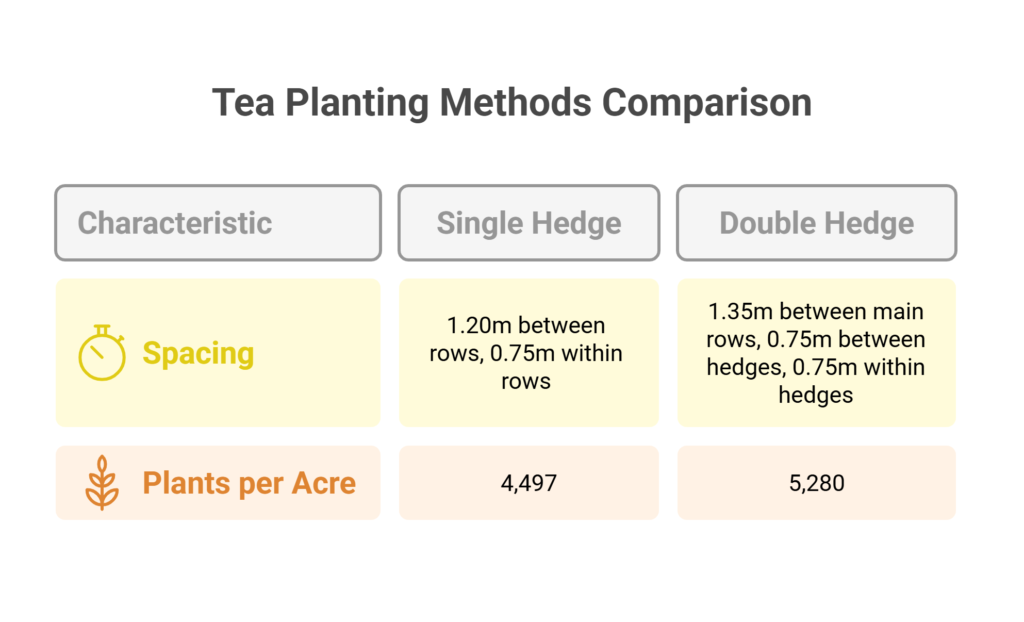
b). Spacing
Single Hedge System
The Single Hedge System employs a precise spacing arrangement of 1.20 meters between rows and 0.75 meters between individual tea plants within rows, achieving an optimal density of approximately 4497 plants per acre.
Double Hedge System
The Double Hedge System is a planting technique commonly used in tea cultivation to optimize space utilization and enhance productivity. In this method, tea plants are arranged in a staggered pattern within closely spaced rows, adopting a specific spacing configuration of 1.35 meters between the main rows and 0.75 meters between the hedges within a row.
Additionally, a 0.75-meter gap is maintained between individual plants within each hedge. This arrangement allows for efficient use of land while ensuring adequate spacing for air circulation, sunlight penetration, and access for maintenance activities such as pruning, pest control, and harvesting. The system promotes uniform growth, maximizes yield, and simplifies plantation management in both small and large-scale tea estates.
c). Pit Preparation
Pit preparation involves digging holes at marked spacing points measuring 30 cm × 30 cm × 45 cm deep; during excavation, topsoil and subsoil are separated. The topsoil is then amended by mixing with 5–10 kg (11–22 lbs) of well-rotted compost or farmyard manure (FYM), 150–200 g (5–7 oz) of Rock Phosphate (or alternative phosphorus source), and 50 g of Trichoderma viridae biofungicide. This enriched mixture is used to refill the pits, creating a nutrient-rich planting environment optimized for young tea bushes.
d). Planting Method
The planting process begins with selecting healthy, vigorous seedlings aged 9–12 months with pencil-thick stems. Carefully remove the polythene sleeve to avoid root disturbance, then position the plant centrally in the prepared pit, ensuring the critical collar (stem-root junction) sits precisely level with the soil surface—planting too deep risks suffocation, while shallow placement exposes roots.
Gently firm soil around the roots to eliminate air pockets, followed by immediate thorough watering to settle the soil and hydrate the plant. Finally, apply a 8–10 cm (3–4 inch) layer of organic mulch (grass or straw) around the base, maintaining a 5–7 cm gap from the stem to conserve moisture, suppress weeds, and regulate soil temperature.
e). Number of Plants per Acre
Based on the above spacing the following number of plants can be accommodated:
| Planting System | Plants per Acre |
| Single Hedge | 4,497 |
| Double Hedge | 5,280 |
Intercropping
Intercropping is a common practice during the first 2–3 years of tea cultivation to make use of the available space and generate additional income while the young tea bushes establish. Suitable intercrops include legumes like beans and peas, which fix nitrogen in the soil, as well as crops like ginger, pineapple (in tropical regions), and short vegetables.
These crops should be low-growing, non-climbing, and non-competitive for water, nutrients, or light to avoid adversely affecting the growth of young tea plants. Careful management is essential to ensure that the intercrops do not damage the developing tea bushes.
Irrigation
Irrigation is critical during the establishment phase (first year) and during dry spells or drought periods in mature fields. The most common methods include sprinklers, which simulate rain but can increase disease risk if foliage remains wet, and drip irrigation, which is gaining popularity for its water efficiency, ability to deliver water directly to the root zone, and reduced weed growth and disease risk, though it has a higher initial cost.
The frequency and amount of irrigation depend on factors such as soil type, weather, plant age, and the irrigation system, with the primary goal being to maintain adequate soil moisture (not saturated) in the root zone (top 30–45 cm). Frequent, light irrigations are generally preferable to infrequent heavy soakings.
Fertilizer and Manure
Apply manure two months after planting. Use 32-40 kg/acre of rock phosphate annually, placed at a depth of 6-10 inches, until the first pruning, after which phosphorus should be applied every two years. Maintain an N:K ratio of 2:3 for the first three years and adjust to a 1:1 ratio from the fourth year onward.
Fertilizer Application Guide (per year per acre) for N & K.
| Year of Application | Total N (kg/acre/year) | Total K (kg/acre/year) | No. of Applications | Ammonium Sulphate per Plant (g) | Urea per Plant (g) |
| I Year | 72.9 | 111.4 | 5 | 13 | 27 |
| II Year | 97.1 | 145.7 | 6 | 23 | 15 |
| III Year | 121.5 | 182.2 | 6 | 29 | 18 |
| IV Year onwards | 121.5 | 121.5 | 6 | 33 | 19 |
(Source: TNAU)
To make sure the plants use fertilizers efficiently, they should be administered right before the monsoon season begins. Spreading the fertilizer evenly around the base—the spot underneath the plant’s outer canopy where water naturally drips from the leaves—is the best way to apply it.
The base of the plant, sometimes referred to as the collar, should not come into direct touch with fertilizers since this could harm the plant or result in ineffective nutrient uptake. For the best possible plant development and health, timing and distribution are essential.
Weed Control
| Aspect | Details |
| Criticality | Weeds compete fiercely with young tea plants for water, nutrients, and light. |
| Control Methods | Mechanical/Cultural: |
| – Regular hand weeding (hoeing) | |
| – Mulching (suppresses weeds, conserves moisture) | |
| – Maintaining a cover crop in alleys (e.g., Pinto Peanut) | |
| Chemical (Herbicides): | |
| – Pre-emergent herbicides (e.g., Diuron, Oxyfluorfen) applied to clean soil to prevent weed germination. | |
| – Post-emergent herbicides (e.g., Glyphosate) used carefully as a directed shield spray under bushes; NEVER sprayed over the top. | |
| – Strict adherence to label instructions to avoid damage to tea plants. | |
| Timing | Focus on keeping the area weed-free during peak growing seasons and before fertilizer application. |
Training and Pruning
In young tea establishment, centering—removing the apical growing point while retaining 8–10 mature basal leaves—is performed post-establishment to stimulate secondary branch development; once these secondaries exceed 60 cm, tipping at 50–55 cm height (removing 3–4 leaves and the terminal bud) induces tertiary branching, with plucking maintained at the mother leaf stage to prioritize frame formation, requiring 18–20 months from planting to achieve a regularly pluckable canopy.
For mature bushes, pruning—conducted at 4–6 year intervals based on altitude and plant vigor—serves to: (1) maintain pluckable height, (2) invigorate vegetative growth, (3) remove dead/diseased wood, and (4) eliminate congested knots and interlaced branches; prerequisite starch reserves in roots (verified via iodine testing) are essential for robust post-pruning regrowth, with starch-deficient bushes rested 2–3 months prior to pruning.
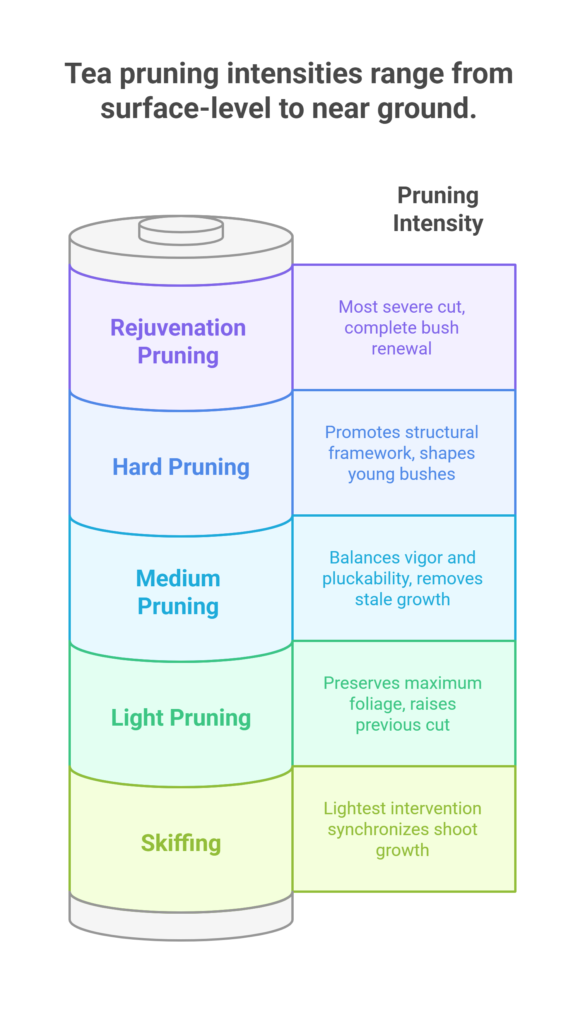
Tea Pruning Methods & Specifications
| Pruning Type | Height/Depth | Primary Purpose | Key Characteristics |
| Rejuvenation Pruning | <30 cm (near ground level) | • Complete bush renewal • Stimulate vigorous new growth from base | • Most severe cut • Resets plant physiology • Used for declining/old bushes |
| Hard Pruning | 30–45 cm (12–18 inches) | • Shape young bushes • Promote structural framework | • Also called Formation Pruning • Encourages lateral branch development |
| Medium Pruning | <60 cm | • Control excessive height • Renew productive wood • Maintain accessible foliage | • Balances vigor & pluckability • Removes woody/stale growth |
| Light Pruning | Slightly above medium pruning | • Minimally reduce height • Maintain plucking table (~65 cm) | • Raises previous cut by 2–3 cm • Preserves maximum foliage |
| Skiffing | Top 5–8 cm removal | • Level plucking surface • Synchronize shoot growth | • Lightest intervention • Annual/biennial maintenance • Surface >65 cm post-trim |
Pest and Disease Management
Common Pests
a). Mites (Red Spider Mite, Scarlet Mite)
The red spider mite (Oligonychus coffeae) primarily infests the upper surface of mature tea leaves, causing damage that can hinder plant health and productivity. To control this pest effectively, use Tetradifon (8 EC) at a rate of 400-500 ml per acre. Ensure thorough coverage of the affected foliage while applying but avoid over-spraying to minimize wastage and potential harm to non-target organisms. This treatment is critical for maintaining the health and yield of the tea crop.
b). Tea Mosquito Bug
Regular monitoring of tea mosquito bug incidence is essential to manage infestations effectively. To reduce their population, remove alternate host plants such as neem, cashew, and guava from the surroundings. For mild infestations, spray any one of the following insecticides: Imidacloprid at 0.6 ml per liter of water, Thiamethoxam at 0.6 g per liter, or Profenophos at 2 ml per liter, ensuring proper application for effective control.
c). Thrips, Caterpillars (Looper, bunch)
Common pests called thrips can seriously harm crops by eating on plant tissues, which results in discoloration and weakened vigor. One of the suggested pesticides must be sprayed at the prescribed dosages for effective control. A 5% neem extract concentrate applied at 5.0 ml per 10 liters of water, or a 1% EC neem-based product applied at 2.0 ml per liter of water are two examples of formulations based on azadirachtin.
It is possible to employ chemical insecticides such as Profenofos 50% EC at 2.0 ml per liter of water or Ethion 50% EC at 5.0 ml per 10 liters of water. Maintain consistent coverage during application, adhering to label directions and safety precautions to reduce environmental impact and attain the best possible pest control.
d). Aphids
Aphids are sap-sucking pests that can weaken plants by feeding on their juices, causing stunted growth, distorted leaves, and reduced yields. Effective management involves spraying Phosalone 35% EC at a concentration of 2.0 ml per liter of water. This insecticide targets aphids effectively, ensuring their population is reduced to manageable levels. Apply the spray evenly on affected plants, focusing on the undersides of leaves where aphids commonly hide. Follow recommended safety precautions and application guidelines to protect beneficial insects and avoid environmental contamination while ensuring optimal pest control.
e). Scale insects
When scales cling to plant surfaces, they draw sap and harm the plant by yellowing, reducing its vigor, and occasionally killing it if treatment is not received. Use 2 g of Carbaryl 50 WP per liter of water to efficiently control scales. Due to the tendency of scales to gather in obscure places, make sure that all afflicted plant parts—branches, stems, and leaves—are thoroughly covered.
When applied correctly in the early stages of infestation, serious harm can be avoided and the pest population can be greatly decreased. To reduce hazards to non-target organisms and the environment while guaranteeing efficient pest management, always follow safety precautions and application directions.
f). Termites (young tea)
Termites can severely damage young tea plants by feeding on roots and stems, causing stunted growth or death. Preventive measures include removing termite mounds, maintaining proper irrigation, and applying organic amendments. In case of infestation, apply recommended termiticides around plant bases and entry points, ensuring early detection and clean plantation practices to minimize damage.
g). Nematodes
Nematodes, particularly Meloidogyne javanica and Meloidogyne incognita, are significant pests in tea nurseries, causing the formation of galls on the roots of infested plants. These galls disrupt nutrients and water uptake, leading to stunted growth and poor plant health. Effective management begins with pre-treatment of the soil media by heating it to 60-80°C, which eliminates nematode populations and other soilborne pathogens.
Additionally, applying Carbofuran 3G at a rate of 80 g per cubic meter of soil medium provides further control, ensuring a nematode-free environment for young plants. These measures are critical for establishing healthy nurseries and ensuring vigorous plant growth. Always follow safety guidelines when handling soil treatments and nematicides.
Common Diseases
a). Blister Blight
Blister blight, a damaging fungal disease in tea plants, can be effectively controlled through regular and targeted spraying. Apply 210 g of Copper Oxychloride combined with Nickel Chloride per hectare at 5-day intervals from June to September and at 11-day intervals during October and November. Alternatively, spray Hexaconazole at 200 ml combined with Copper Oxychloride at 210 g per hectare at 5-day intervals. These measures help manage the disease during its peak periods, ensuring plant health and productivity. Always follow safety guidelines and recommended dosages during application.
b). Grey Blight
Premature leaves drop and decreased production are the results of grey blight, a fungal disease that causes greyish-brown lesions on tea leaves. It grows best in humid environments and, if left unchecked, can spread quickly. In order to preserve plant health and productivity during the disease-prone season, controlling grey blight entails routine monitoring, ensuring enough air circulation, and using the proper fungicides.
d). Black Root disease
Black root disease caused by Rosellinia arcuata is characterized by black mycelium on the roots, white star-shaped mycelium between the bark and wood, and black, lead shot-like perithecia visible on the collar region of the plant. To control this disease, soil drenching with Dithane M-45 at a rate of 30 g per 10 liters of water is recommended. This treatment helps suppress the fungal pathogen in the soil, protecting the roots and collar area from further infection and promoting healthier plant growth.
f). Algal Leaf Spot
The formation of greenish or blackish dots on the leaf surface brought on by algal growth is the hallmark of algal leaf spot, a frequent disease that affects tea plants. If these spots are not controlled, they can lower photosynthesis and general plant health. The occurrence of this disease can be decreased with the use of appropriate cultural measures, such as ensuring balanced fertilization, preventing extended leaf wetness, and keeping enough air circulation. In extreme situations, the tea plants’ health may be safeguarded and algal growth controlled with the use of suitable fungicidal sprays.
Harvesting
| Aspect | Details |
| Commencement | Plucking begins when the tea bush is 3 years old. |
| Target Shoot | Terminal shoot (“Two leaves and a bud”): Unopened bud + 2 leaves. |
| Fine Plucking | Any shoot with less than “Two leaves and a bud”. |
| Plucking Type | • Light Plucking: Above the mother leaf (maintenance foliage). • Hard Plucking: Below the mother leaf (adds a tier of foliage annually in Jan-Mar). |
| Shoot Maturity | Takes 60–90 days from bud sprouting to reach pluckable size. |
| Labor Intensity | Highly labor-intensive; critical for yield and quality. |
| Plucking Intervals | South India: • Mar-May: Weekly • Other Months: Every 10-14 daysGeneral: • High-Cropping (Apr-Jun, Oct-Dec): Every 7-10 days (yields ~60% of annual crop) • Low-Cropping (Jul-Sep, Jan-Mar): Every 12-15 days (yields ~40% of annual crop) |
| Canopy Management | Level Plucking: Maintains the plucking table canopy outside of mother leaf plucking periods. |
Yield
The yield of green tea leaves is approximately 9 tons per acre per year.
Post Harvest Management
| Process Step | Objective | Method/Equipment | Duration | Key Conditions/Notes |
| Withering | Reduce moisture content; Achieve flaccid leaves | Leaves spread in troughs with artificial air blown by fans | 12-18 hours | Depends on weather conditions |
| Rolling | Break leaf cells to liberate sap & enzymes; Initiate oxidation | Done by series of machines or single roller | 30-40 minutes | Result: Polyphenol oxidase oxidizes polyphenols → produces theaflavins & thearubigens (color compounds). Sorting: Fine sifted → Fermentation; Coarse → Re-rolled |
| Fermentation | Develop strength, color & briskness | Rolled tea spread on concrete floors or kept in aluminum trays | 1-2 hours | Requires high humidity & proper step control (critical for quality). Depends on environmental conditions. |
| Drying | Stop fermentation; Remove moisture slowly without burning; Preserve quality | Fermented tea passed in thin layers through conveyor drier | 30-40 minutes | Temperatures: – Inlet: 250–280°F – Outlet: 150–200°F |
| Grading | Separate into quality grades; Remove stalky fibres | 1. Fibre Removal: Passed through fibre separation machines. 2. Size Separation: Bulk tea passed through different sized meshes. | Not specified | Stalky fibres negatively affect quality. |
Cost of Investment per Acre for Tea Farming
| S.N. | Category | Estimated Cost (NRs.) |
| 1 | Land Preparation | 25,000 |
| 2 | Tea Seeds/Saplings | 20,000 |
| 3 | Fertilizers and Manure | 20,000 |
| 4 | Irrigation System (Drip) | 150,000 |
| 5 | Labor (Planting, Maintenance) | 15,000 |
| 6 | Pest & Disease Control | 25,000 |
| 7 | Harvesting, Sorting, Drying | 25,000 |
| 8 | Miscellaneous Costs | 20,000 |
| Total Initial Investment | 300,000 |
Annual Maintenance Cost
The annual maintenance cost for tea farming, starting from the second year onwards, is projected to be NRs. 50,000 per year. This expenditure encompasses a range of essential activities to ensure the sustained health and productivity of the tea plantation.
These activities typically include regular pruning to maintain the plants’ shape and vigor, weed control to minimize competition for nutrients, fertilization to replenish soil fertility, and pest and disease management to protect the crop from potential infestations.
Additionally, this cost may cover irrigation system upkeep, labor for routine farm operations, and minor repairs to infrastructure such as pathways or shade netting. Investing in consistent maintenance not only helps in preserving the quality of tea leaves but also maximizes yields and extends the productive life of the tea plants, making it a critical aspect of the overall farming operation.
Income from Tea Farming per Acre
| Year(s) | Yield (kg) | Price (NRs/kg) | Income (NRs.) | Costs (NRs.) | Annual Profit (NRs.) | Cumulative Profit (NRs.) |
| Year 1 | 0 | – | 0 | 300,000 | (-300,000) | (300,000) |
| Year 2 | 0 | – | 0 | 50,000 | (-50,000) | (350,000) |
| Year 3 | 2,500 | 30 | 75,000 | 50,000 | 25,000 | (325,000) |
| Years 4-10 | 5,000/yr | 20 | 100,000/yr | 50,000/yr | 50,000/yr | +350,000 (by Y10) |
| Years 11-20 | 8,500/yr | 25 | 212,500/yr | 50,000/yr | 162,500/yr | +1,975,000 (by Y20) |
| Years 21-30 | 5,000/yr | 30 | 150,000/yr | 50,000/yr | 100,000/yr | +2,975,000 (by Y30) |
| Years 31-40 | 3,000/yr | 40 | 120,000/yr | 50,000/yr | 70,000/yr | +3,675,000 (by Y40) |
Analysis of Tea Farming Profit Per Acre
The break-even point is reached in Year 11, where cumulative profit turns positive, with total investment recovery by the end of Year 10. Key phases include Years 1–3 (heavy losses due to initial investment and low yield), Years 4–10 (steady annual profit: NRs. 50,000), Years 11–20 (peak profitability: NRs. 162,500/year), and Years 21+ (declining but positive returns from yield reduction).
Over 40 years, total income is NRs. 8,925,000, total costs (initial NRs. 300,000 + 39 years of NRs. 50,000 annual maintenance) are NRs. 2,250,000, resulting in a net profit of NRs. 6,675,000. This translates to an average annual profit of NRs. 166,875/acre and a return on investment (ROI) of approximately 2,225%, calculated as (Net Profit / Total Investment) × 100 = (6,675,000 / 300,000) × 100.

